|
THE DESTRUCTION OF 73
CHEVENING ROAD
INTRODUCTION
My grandparents' house,
73 Chevening Road, Kensal Rise, London NW6, was
destroyed in World War II.
My dad tells the story that, one evening in
October 1940, two weeks before his fourth birthday, his father was
putting him to bed in the air raid shelter in the garden when the house
took a direct hit from a German bomb. His mother - my grandmother - was
in the house at the time and miraculously survived, although she
suffered an arm injury which required hospitalisation. He and other
family members believe the trauma of this event also led to her
development of chronic depression from 1948, which haunted her for many
years.
My dad
remembers the inside of the air raid shelter and even how it smelt! He
remembers, in the immediate wake of the bombing, being in his father's
arms in the queue for the reception centre, which was at the synagogue
on the corner of Chevening Road, where he would be Bar Mitzvah some nine
years later.
Beginning in the summer of 2008, I have been investigating the
destruction of the house, in an attempt to find out what information was recorded about
it. This page presents the fruits of my research.
THE LAST BOMB?
My dad
has always included in his telling of the story that enemy bombing had
occurred that night on the rail tracks at nearby Willesden Junction. He
believes that one German plane, having completed its drop, was
returning to base when it was realised that there was one bomb remaining
in the hold. It was released and landed on 73 Chevening Road. My dad
remembers a phrase being used, to the effect that his mother was "the
only one to come out alive" from the wreckage of the house,
suggesting there were a number of fatalities, but no-one in our family
was killed.
CHEVENING ROAD TODAY
Chevening Road is a very long residential road running broadly
south-west to north-east, nearly a mile in length, with large Edwardian
(or perhaps late-Victorian) houses on both sides. There is a
break in the original housing where numbers 71, 73 and 75 stood,
implying that three houses were destroyed, of which my grandparents' was
the middle one.
Google Earth allowed me to establish that No 71
was the last in a terrace of four houses, while Nos 73 and 75 were the
first set of semi-detached houses which make up the second half of the
road. In place of the destroyed houses is a small block of six flats obviously
built after the war to replace them:
|
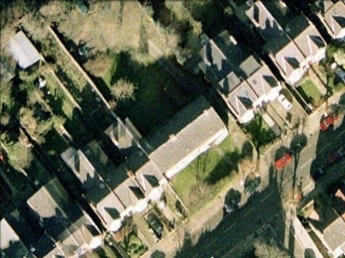 |
|
Chevening Road today,
showing the block of
flats that replaced the three
destroyed houses
(Photo: Google Earth, 5 March 2006) |
|
|
|
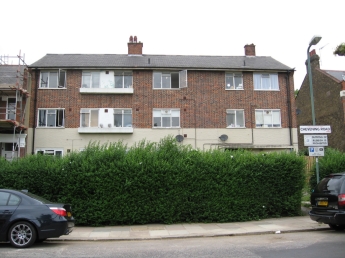 |
|
The block of
flats from the ground
(Photo: Saul Marks, 17 July 2008) |
|
| |
|
|
In order to get a good idea
of what the original 73 Chevening Road looked like, I took a photo of No
77, which is exactly the same type of semi-detached house as No 73 was:
|
 |
|
Nos 77 and 79 Chevening
Road, which are effectively identical to the
original Nos 73 and 75,
which were both destroyed, along with No 71.
The detailing in the windows
of No 77 is almost certainly original and
suggests the houses were
built in the Edwardian era.
(Photo: Saul Marks, 17 July 2008) |
|
HOSPITAL
To the right is the
discharge certificate from my grandmother's stay in hospital, which we
found amongst her papers when she died in 1999. The full text reads:
|
Mrs Marie Marks, aged 27, of 73
Chevening Road, NW6, was under inpatient treatment from 14:10:40
to 4:11:40 at Willesden General Hospital, suffering from
contusion of nerves of right arm, the result of war injury on
14:10:40 at Willesden. |
This was the first piece of
documentary evidence I ever obtained that related to the incident, and
it fixes the date of the destruction of the house:
MONDAY 14 OCTOBER 1940
|
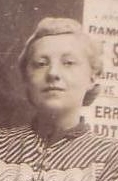 |
|
Marie Marks
c.1938 |
|
|
 |
|
Marie Marks' hospital
discharge certificate, having survived the bombing |
|
RAF RECORDS
The RAF have uploaded their
contemporary reports of the Battle of Britain to their website, and they make
fascinating reading. The entry for 7.00pm to 9.00pm on the evening of 14
October reads:
|
About 27 raids from the Dutch
Islands entered the Thames Estuary and crossed the Coast between
Shoeburyness and Orfordness. The majority flew over London from
the north, but a few appeared to be active over East Anglia.
About 40 raids from the direction of the Somme and Fecamp
Crossed the Coast between Shoreham and Dungeness and flew to the
London area. Raids from the Channel Islands crossed the Coast
between Poole and Portland and flew to the Birmingham and
Coventry areas. Isolated raids were plotted over Liverpool,
Blackburn and Preston. |
There is no mention of an
attack on Willesden Junction, although the railway lines at nearby
Queens Park were targeted the following evening.
My dad
was a toddler at the time and his version of the circumstances would
have originated from someone else, most likely one of his parents or
another adult. As such, it may have been slightly distorted as it was
passed through various sets of lips and ears, or it may have been
inaccurate or merely conjecture to begin with. Three adjacent houses in
the middle of a residential area were clearly not the target of the air
raid and would not have taken a large number of bombs to destroy them.
This is consistent with the idea that one bomber dropped the remainder
of his load randomly on his return to base, but it is unlikely that this
can ever be proven.
DAMAGE
Although the Kensal Rise
district is very much part of Greater London today, during the war it
was controlled by Middlesex County Council, who compiled logs of the air
raids that took place. Their log book for the Borough of Willesden on 14
October 1940 reads:
|
Date |
Message Time |
Incident Time |
Particulars |
Remarks |
|
14/10/40 |
19.55 |
|
Bombing |
Prelim. report |
|
" |
20.48 |
20.00 |
Major damage
– H.E. Chevening Road blocked by crater and debris between
Kingswood Avenue & Peploe Road. Harvest [sic] Road also blocked
at junction with Peploe Road. |
Harvist Road
cleared 17.45 12/3/41 |
"H.E." stands for "high
explosive" and is different from incendiary bombs; both were used in
great numbers by the Luftwaffe. The portion of Chevening
Road between the junction with Kingswood Avenue and the junction with
Peploe Road does include Nos 71-75, which were directly opposite the
junction with Peploe Road. The timing is certainly consistent with the sort of
time a young couple might put their three year-old to bed.
The fact that Peploe Road's
other end, where it joins Harvist Road, was also blocked, suggests that
perhaps there were several properties in the vicinity that were damaged
in what was effectively the same incident. With a little imagination,
it could be suggested that the same aeroplane had several bombs
remaining in its hold and released them as it flew over the district,
leaving a trail of destruction. This would also be a fairly direct route
south, back towards the area from which they came, as defined in the RAF
report.
This log book is held at
London Metropolitan Archives who, along with The National Archives, hold
various maps of the bombing that took place in the area. Strangely, I
have not found any indication of this incident on any map, or on the
"Bomb Census", which tended only to record instances of major loss of
life.
FAMILIES
The 1940 street directory
lists the heads of household for the homes that were
destroyed:
|
71 Chevening Road |
Miss N Stevens |
|
73 Chevening Road |
Sam Marks, Israel Goldberg |
|
75 Chevening Road |
Frederick Alfred
Basten, Frederick Watson |
The 1939 electoral roll (the
last one published before the war) gives more details:
|
71 Chevening Road |
Mary Jane Howard
Harriett [sic] Rebecca Knowles
Nellie Eliza Stevens |
|
73 Chevening Road |
Annie Yetta Goldberg
Bertha Goldberg
Emanuel Goldberg
Israel Goldberg
Marie Marks
Sam Marks |
|
75 Chevening Road |
Emily May Basten
Frederick Alfred
Basten
Gwendoline Florence Watson
Joseph Frederick Watson
Winifred Kate Watson |
The listings for No 73 show
my grandparents living with my grandmother's family, the Goldbergs.
Israel and Chana Ita (listed here as Annie Yetta) were Marie's parents,
and Bertha and Manis (listed here incorrectly as Emanuel) were two of
her siblings. After the war, the Goldbergs lived in a three-storey
Victorian house in Maida Vale, with different floors occupied by various
different branches of the family, but my dad and I never realised that a
similar arrangement existed at Chevening Road until I consulted these
sources. My grandparents married in October 1934 and first appear at No
73 in the 1935 electoral roll; they were joined there by the Goldbergs
the following year.
I have researched the families who were listed at Nos
71 and 75, in
the hope that their families' oral histories might contain more detail
about the destruction of the three houses.
Nellie Eliza Stevens
(1879-1958) was a spinster in her
early 60s who was born in Chelsea and died in Surrey. She first appears
at No 71 in the 1928 street directory and shared the house with various
different families over the following years, suggesting she owned it and
rented part of it out. Nellie had one sister, also a spinster, and a
brother, William Thomas James Stevens (1877-1945). I believe William may
have grandchildren still alive, and they are my next source of research.
Interestingly, the Stevens family connections with Chevening Road go
back further than Nellie's arrival in 1928: in 1911, she was living with
her father and sister at No 92 while William and his family were living
at No 100.
Harriet Rebecca Knowles
(1863-1942) was a widow in her
late 70s. She first appears at No 71 in the 1933 electoral roll, along
with her husband Frederick (c.1861-1935), presumably as lodgers of
Nellie Stevens. She and Frederick had two children, Eveline May Sparrow
(1889-1967) and Ernest Frederick Knowles (1895-1961), both of whom were
married before the destruction of the houses in Chevening Road. Eveline
had two children, neither of whom appear to have had children and both
of whom are deceased; Ernest
had no children, meaning there are no direct descendants of Harriet
Rebecca Knowles alive to ask about the bombing.
Mary Jane Howard (1860-1940)
was Harriet Knowles' elder sister, also a spinster, who died in the
second quarter of 1940, a few months before the destruction of the
houses. She seems to have moved into No 71 at the same time as Harriet
and Frederick.
Frederick Alfred Basten (1904-45) had married Emily
May Howe (1911-62) in 1933 and, at the time of the bombing, had two sons, John
(aged 5) and Peter (4). He went on to have a third son, Michael, before
being killed in Belgium in January 1945, whilst serving in the Royal
Army Service Corps. I have spoken to Peter and two of his cousins but,
even though one cousin remembers Frederick living at 75 Chevening Road,
none are aware of any stories within the family of the
house being bombed. The Basten family is only listed at No 75 in the
1939 electoral roll and the 1940 directory, so they only lived there for
a very short time, presumably as lodgers of the Watsons, below.
Joseph Frederick Watson (b.1887) had married Winifred Kate Gurney
(1892-1942) in 1913 and had at least four children, the eldest of whom,
Stanley, had died in 1922, aged 8. The others, at the time of the
bombing, were Gwendoline (25), Joan (20) and Patricia (15). The Watson
family first appears at No 75 on the 1936 electoral roll and it appears
that they, like Nellie Stevens at No 71, took in a different family of
lodgers each year.
GWENDOLINE FLORENCE
WATSON
Tragically, the Commonwealth
War Graves Commission reveals that Gwendoline was killed when 75 Chevening
Road was destroyed. The entry on their database reads:
|
Name |
Gwendoline Florence Watson |
|
Nationality |
United Kingdom |
|
Regiment/Service |
Civilian War Dead |
|
Age |
25 |
|
Date of Death |
14 October 1940 |
|
Additional Information |
Of 75 Chevening
Road. Daughter of Mrs. W. Watson. Died at 75 Chevening Road. |
|
Cemetery |
Willesden Municipal Borough |
This is the most overt and
specific reference to the destruction of the houses that I have found
anywhere to date. It also ties in with the phrase my dad remembers,
which suggested that some people lost their lives, although I have not
found any other civilian deaths that might relate to the incident in the families I have researched. The listing also suggests that Gwendoline's father was no
longer alive, despite the house appearing in his name in the street
directory of that year. To make things even more tragic, Gwendoline's
mother Winifred died two years later.
I have not been able to
trace Gwendoline's sister Joan, but her youngest sister Patricia married
a man named John Kennaghan in 1947. Despite the fact that Kennaghan is a
very uncommon surname, I have failed to find them, their deaths or any children they
may have had, so I think they may have emigrated. Winifred's sister
Isabel moved to Australia, so the remnants of Gwendoline's family could
have joined them. I traced the
daughter of a cousin of Gwendoline's on her father's side, but she
related a story told by her late mother that Gwendoline's house was
damaged by a rocket towards the end of the war. This is clearly a
different incident and a different house, so the lady has
referred me to a distant cousin who lived in the Chevening Road district
almost all his life. I am hoping he may be able to give at
least a second-hand account of the bombing, although he is now 97 and is
in a home.
Gwendoline was buried on
Monday 21 October 1940, a week after the houses were destroyed:
|
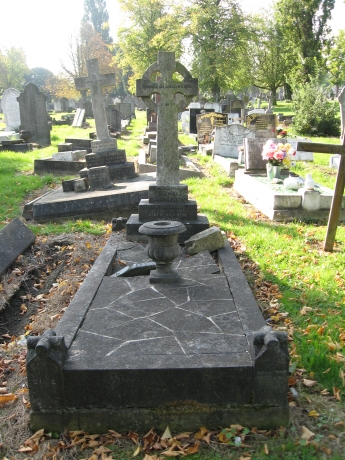 |
|
The rather dilapidated
Watson family grave at Willesden New Cemetery (Section
E, plot 91)
(Photo: Saul Marks, 12
October 2010) |
|
|
|
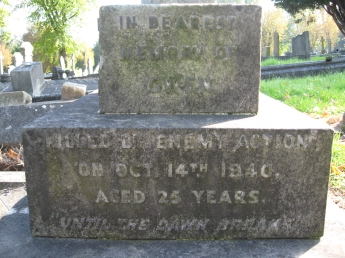 |
|
Gwendoline's inscription, on
the side of the stone
(Photo: Saul Marks, 12
October 2010) |
|
|
|
|
The inscriptions on
the tombstone read: |
|
|
|
In loving remembrance of our dear
little son, Stanley Frederick Watson, who fell asleep on April
4th 1922, aged 8 years, 9 mths. "Sadly missed."
Also of our dear mother, Winifred
Watson, who passed away Nov. 22nd 1942, aged 50 years. "Always
in our thoughts."
In dearest memory of Gwen, killed by
enemy action on Oct. 14th 1940, aged 25 years. "Until the dawn
breaks." |
|
| |
|
|
NEWSPAPERS AND
PUBLICATIONS
The Kilburn Times and the
Willesden Chronicle would have been the most likely papers to cover air
raids in the Kensal Rise district. Thanks to Brent Archives, I
have obtained the front page of the Willesden Chronicle from Friday 18
October 1940, in which it relates the story of the week's raids. For 14
October, the report reads:
|
FIERCE RAIDS ON MONDAY
Monday night's raids began early and
finished late, and soon after the alert went the sound of
falling bombs was heard in many areas. They continued falling
every few minutes for several hours.
A bomb dropped onto a heap of coke
stored in the grounds of a Grammar School, made a huge hole,
scattered fuel and earth all over the place and broke a large
number of windows on the opposite side of the road.
Another bomb fell onto a recently
erected block of flats in a residential locality and completely
demolished it. Fortunately, there were no residents in the
flats.
A third high explosive bomb dropped
on to a large detached house standing in its own grounds. A heap
of ruins was all that remained after the explosion, and it
seemed strange to see handsome window curtains which had been
blown to the trees in the garden, waving in the breeze.
In this area, too, a "Molotov
cocktail" was dropped on to roofs and in the road, but the
speedy work of residents and A.R.P. workers prevented much
damage from being done.
In another suburban district houses
were damaged by high explosive bombs. Fortunately casualties
were mostly of a minor nature. |
Frustratingly, the wartime
reporting restrictions and the desire to keep morale up as much as
possible mean that very few reports from this time are as explicit as we
would expect today. The final paragraph of this portion of the report is
consistent with the other information about the Chevening Road bombing,
with the word "mostly" possibly being used to disguise the fact that one
young woman lost her life and another was injured when their homes were
destroyed.
The issues of the Kilburn
Times dated 18 and 25 October are held at the British Library's newspaper
archive
in London. The staff there inform me that the Chevening Road incident
cannot be pinpointed in either edition due to the vagueness of the
reports.
In 1994, Kenneth J Valentine
published "Willesden at War: the Impact on the Community", which devotes
a number of pages to what is effectively a month-by-month chronology of the Blitz
in the district. Page 23 includes the following paragraph:
|
October began badly with nine people
killed at 130-132 Manor Park Road but in the month as a whole
the death rate from air raids (about 17 a week) was only half
what it had been in September. Bomb incidents cost four lives in
Connaught Road Harlesden on the 5th and four more in Ellesmere
Road on Dudden Hill on the 9th; five lives were lost in Mortimer
Road on 16 October; four in Oxford Road on the 20th; and four at
Guinness's factory in Park Royal on the 25th. |
Frustratingly, despite such
detail, there is no mention of the Chevening Road incident. Those
mentioned are incidents with four or more fatalities, so the lack of
mention of Chevening Road supports the theory that Gwen Watson was the
only one to be killed in the incident. The quoted statistic of around 17
deaths per week translates to around 68 per month; 30 are included in
the named incidents, leaving at least the same number again as
casualties of smaller incidents, like Chevening Road.
EPILOGUE
Brent Archives hold various
schedules of cleared bomb sites, categorised by the Town Planning &
Development Committee in the summer of 1950. The Chevening Road site
appears in the tables as follows:
|
Site No |
27 |
|
Address |
71-75 Chevening Road |
|
Category |
B ("Recommended for acquisition by
housing sub-committee but 'no action' by special sub-committee") |
|
Description |
Chain link fencing, over-grown dump |
|
Frontage (feet) |
72 |
|
Area (acres) |
0.310 |
|
Recommendations or Observations |
Recommend acquisition for housing
purposes |
The sad description reflects
the fact that, by this time, the site had lain derelict for a decade.
Three smart Edwardian properties, home to six families, had been
reduced to an overgrown dump surrounded by chain-link fencing. It was,
of course, "acquired for housing purposes" and the flats erected.
My research continues,
"until the dawn breaks"...
|
Sources
Nachum Marks
Google Earth
RAF Battle of Britain website:
http://www.raf.mod.uk/Bob1940/october14.html
Borough of
Willesden air raid log book: (at London Metropolitan Archives, ref
MCC/CD/WAR/1/24)
Willesden street
directories (at Brent Archives)
Willesden East
electoral rolls (at London Metropolitan Archives)
Censuses of
England & Wales:
http://www.ancestry.co.uk
GRO civil
registration indexes:
http://www.ancestry.co.uk,
http://www.freebmd.org.uk
Commonwealth War
Graves Commission:
http://www.cwgc.org
Willesden
Chronicle, 18 October 1940 (at Brent Archives)
Kilburn Times,
18 & 25 October 1940 (at the British Library's newspaper archive)
Valentine,
Kenneth J (1994), "Willesden at War: the Impact on the
Community", ISBN 0-951-42581-1
Borough of
Willesden Town Planning & Development Committee papers (at Brent
Archives) |
|
Saul Marks
Rev 4 Jan 2011 |
|